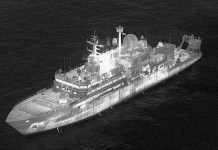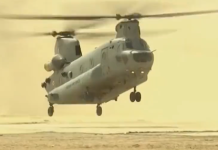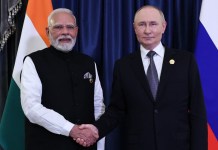Dragon Fire, a novel by British author Humphrey Hawksley, written 20 years ago depicted a war erupting between China, India and Pakistan, drawing many other countries and then escalating into a nuclear catastrophe.
In the wake of the recent India-China border standoff that resulted in the killing of 20 Indian soldiers, Hawksley, a former BBC correspondent, said India has missed the bus to be a role model for its neighbours despite its democratic credentials. But he said that with the US alongside, India would be a formidable front to balance China’s rise.
“If China is to prevail in Asia, it needs India onside and it would not achieve that by clubbing Indian soldiers to death on a disputed border,” said the author.
In an exclusive interview with Anadolu Agency from London, Hawksley said the two countries China and India have differing capabilities. He said while China might be authoritarian, violating human rights and international law, it has shown decisive political leadership, unlike India.
“China is generations ahead beginning with basic health statistics. A newborn baby in India is three times more likely to die in its first year than it is in China. “India has failed to address its challenges of poverty, corruption, forced labour, and the rest, using its democracy as a fig leaf of an excuse,” he said.
Dragon Fire plays out a doomsday scenario with an Indian special unit invading a prison in the Tibetan capital Lhasa to free Tibetan religious leaders. As China declares war, Pakistan also launches an attack on the strategic outpost of Kargil. The war leads to the use of weapons of mass destruction.
Twenty years down the line, Hawksley said that Kashmir will get more affected than Tibet in the fight between the elephant and the dragon. While the elephant symbolizes India, the dragon is often used to describe Chinese prowess.
The author, whose recent book Asian Waters: The Struggle Over the Indo-Pacific and the Challenge to American Power discusses the US-China tensions in the South China Sea, said India appears to have little concept of regional power projection.
“It [India] failed to go after the Tamil Tigers in Sri Lanka after the assassination of Rajiv Gandhi. It was Chinese, not Indian intervention, that killed Prabhakaran [founder of Tamil Tigers] and ended the Tigers,” he told Anadolu Agency. The former Indian prime minister was killed in 1991.
Hawksley further said while India dwells obsessively on the 1962 Sino-Indian war, it has rarely put it in context of its good relationship with the US, the simultaneous Cuban missile crisis, and China’s fear of a US nuclear strike that made Beijing withdraw.
“India is losing influence in Nepal and Bhutan which should have been within its arc of influence. It has failed to create a working regional institution out of SAARC,” he said, referring to the South Asian regional bloc.
Anadolu Agency (AA): Your novel, Dragon Fire has depicted a scenario of war between China, India, and Pakistan — all nuclear countries. What led you to depict this doomsday scenario?
Humphrey Hawksley (HH): I spent much of the 1990s covering Asia for the BBC and, amid all the stories, this common strand of China and Pakistan against India kept coming up time and time again. More than 20 years later, the same issues that sparked the fictional scenario then are sadly alive today, as with the dreadful clashes in the Galwan Valley.
AA: Your book was published a year after the India-Pakistan limited war at Kargil in 1999. The war did not escalate into a full-fledged war. China also remained neutral and even tried to de-escalate tensions. What has changed since then?
HH: China is now a substantive global power with a reach throughout Asia and beyond.
In that respect, Pakistan is even more reliant and entwined with China than it was even then. Kargil was one of the early examples of China and the US working together to defuse a global crisis. The India-Pakistan relationship, Kashmir, and border issues are now embedded within China’s goal of becoming the predominant Indo-Pacific power. To achieve that it needs a neutral India and a compliant Pakistan and will play its cards accordingly.
AA: You have been accurate about the dangers faced by Asia. What is the way out, so that scenarios you have woven in your books, remain in the realm of imagination only?
HH: The quasi-Cold War camps of the US versus China may, ironically, make the region safer. The Indian intervention in Kashmir, the Galwan Valley clash, and a myriad of other issues now have a behind the scenes constant checks and balance by outside governments that could stop the worst scenarios becoming reality. Having said that, China can turn on and off the tap of anti-Indian antagonism which it will use to leverage power. The US, meanwhile, is building a loose alliance of ‘like-minded’ governments of which India is a pivotal player. India, however, prides itself on its non-aligned status, so we will have to see how that unfolds.
AA: I remember, when your book was released, it received praise from then Indian Defense Minister George Fernandes. He was recommending it to every visitor. Why have both countries not been able to settle their boundary dispute using a give and take formula?
HH: Good question, and one that China uses to point the finger of blame at India, saying it has amicably settled many of its border disputes, so why not with India. The Sino-Indian border will remain a disputed tinderbox while China’s strategic expansion continues at such a pace. It is gaining influence in Nepal and Bhutan. It needs to keep its grip on Tibet and Xinjiang. Aksai Chin remains symbolic of the 1962 war and so on. It could only be settled now as part of an encompassing Indo-Pacific agreement and that is not likely anytime soon.
AA: How do you view both countries China and India, in terms of the balance of power, their capabilities and capacities both military, economic, and in terms of decisive political leadership?
HH: There is no real comparison. China is generations ahead beginning with basic health statistics. A newborn baby in India is three times more likely to die in its first year than it is in China. India has failed to address its challenges of poverty, corruption, forced labor, and the rest, using its democracy as a fig leaf of an excuse.
India appears to have little concept of regional power projection. It failed to go after the Tamil Tigers in Sri Lanka after the assassination of Rajiv Gandhi.
It was Chinese, not Indian intervention, that killed Prabhakaran [founder of Tamil Tigers] and ended the Tigers. India dwells obsessively on the 1962 war with China but rarely puts it in context of its good relationship with the US, the simultaneous Cuban missile crisis and China’s fear of a nuclear US strike unless it withdrew. As mentioned, it is losing influence in Nepal and Bhutan which should be completed within its arc of influence. It has failed to create a working regional institution out of SAARC. China, on the other hand, has been addressing head on its poverty, separatism, and power projection. It might be authoritarian, violating human rights and international law, but it is showing decisive political leadership.
AA: Since you wrote a book, another element of the Chinese strategic parameter has been added that is the Belt and Road Initiative. The China-Pakistan Economic Corridor is a flagship of this project. Has it changed the strategic contours of the region?
HH: The Belt and Road Initiative (BRI) has been a global game-changer, and the China-Pakistan Economic Corridor is one of its flagship projects. When Xi Jinping platformed it at the World Economic Forum in Davos in 2017 it caught imaginations around the world. There is now some pushback against it, but it has already bought a range of governments into its arc of influence. Apart from the infrastructure, it is also helping to give China political influence as seen in the recent United Nations Human Rights Council vote on the new Hong Kong security laws – 53 for China, 27 against.
AA: India has been building a lot of infrastructure projects now along borders. Are they any match for China’s infrastructure?
HH: Not really. India’s building of border infrastructure was the catalyst that sparked the Galwan Valley clash. This is different from India matching the breadth of ambition of the Belt and Road Initiative. Vision is important here. BRI symbolizes China’s wealth and pragmatism. It is not selling democracy, ideology, or religion, but roads, hospitals, and airports. As a small example, India could long ago have secured the building of a new airport in Nepal or similar in Sri Lanka. The French are building in Kathmandu, and we all know what happened in Sri Lanka. There is barely any talk about the massive Delhi-Mumbai Industrial Corridor project but much talk about the rise of Hindu nationalism, repression of Muslims, and hostilities with China and Pakistan.
AA: While looking around South Asia, ironically many countries feel comfortable with autocratic neighbour China than democratic India. What are the reasons behind such a phenomenon?
HH: People only have to look at China’s success against poverty and in building infrastructure to ask whether the vote is more important than having a toilet and running water. This sentiment has been compounded by the failure of democracy in Iraq and Afghanistan and the Arab uprisings of some 10 years ago. Add to that the controversy surrounding the election of Donald Trump and, among many Britons, leaving the European Union and a pattern emerges about the benefits of more autocratic systems of government. Singapore is the intellectual heart of this argument. The wider Asia is a continent like none other where there is no prevailing language, the system of government, or religion. Dictatorships, military regimes, and new democracies have to live side by side. Therefore, Asia cannot afford many of the black and white political thinking of the West, summed up in the US mantra ‘you are either for us or against us.’ The Indo-Pacific is a rainbow of different shades of gray.
AA: By extending friendly hands to many countries in South Asia, China has created a diamond necklace in terms of economy and a string of pearls around India. What are the options before India?
HH: India’s best option is to contribute fully to the Quad concept comprising Australia, Japan, India, and the United States and continue reaching out to what is known as ‘like-minded’ governments, such as Vietnam, with which it is forging a close economic and strategic relationship. It would help to bear in mind the ’62 war situation. Beijing timed the military incursion to coincide with the Cuban missile crisis because it thought President Kennedy’s concentration would be on the Caribbean. They misjudged. Kennedy offered India any help it wanted. The day before the Cuban blockade formally ended on Nov. 21, 1962, Beijing declared a cease-fire and withdrew. Beijing may have beaten India on the battlefield, but ultimately it lost because of India’s alliance with the United States.
A similar alliance now is the surest way to balance China’s expansion.
AA: You portrayed Tibet and Kashmir as centers of upheaval. How will these regions get affected by the fight between the elephant and the dragon?
HH: They are both flashpoints, Kashmir more than Tibet because of Pakistan’s history of sponsoring insurgency there and its alliance with Beijing. The Indian-sponsored insurgency into Tibet ended in the 70s.
AA: Your book is also full of tactical details that the armies of both countries possessed in 2000. How far have these capabilities changed since then?
HH: The most relevant change would be in cyber capabilities of which China is further advanced as it is in missile capability, weapons manufacturing, and procurement. As of 2016, while writing my non-fiction Asian Waters: The Struggle Over the Indo-Pacific and the Challenge to American Power, India had 14 submarines against China’s 68, 1,488 fighter aircraft against China’s 2,615 and so on. One advantage India may have is its experience in low-insurgency warfare.
AA: You have mentioned countries like Australia, Japan, and many others getting involved in the conflict, but not Israel, which has been a helping hand for India during its wars with Pakistan be that 1971 war or 1999 Kargil war. Will it be possible for Israel to repeat the feat, in the case of India’s war with China?
HH: Highly likely. Israel is very much part of the ‘like-minded’ government group and is becoming a key supplier of technology-driven avionics, missile systems, and radars. Half of Israel’s defense sales now go to the Indo-Pacific. Israel has also sold to China, but this is now being tempered by the US. Even back in 2002, Israel was about to sell an early warning radar system to Beijing until the US told it to stop.
Q: From Chandigarh to Lhasa, the flight Indian commands are taking looks a straight take away from Israel’s Operation Entebbe or Operation Thunderbolt, when its defense forces rescued hostages from Entebbe Airport in Uganda in 1976.
HH: Interesting observation. I don’t think [I] had Entebbe in mind at all when I wrote it. It was more a straight-forward special forces operation.
AA: You have concluded that China obtained power by force, which would have taken generations to obtain through peace. But as we know that China has already attained a primary role in world politics, with the US increasingly withdrawing. Which power do you think can rise simultaneously to ensure a multipolar world?
HH: 20 years on, with much, changed, one scenario would be for the European Union to forge a cohesive enough front to become a single voice global power. Given China and Russia’s interference in European political and economic institutions, there is a growing impetus to do this. Militarily it could act in partnership with NATO which is comprised mostly of European governments. Economically, the EU is the world’s second-largest economy after China, carrying serious muscle.
With the US alongside, this would be a formidable front to balance China’s rise. India would be a natural partner which could also help guide China away from its current hardline antagonism. If China is to prevail in Asia, it needs India onside and it won’t achieve that by clubbing Indian soldiers to death on a disputed border. In that respect, things are probably different from my analysis in 1999. As an Asian power, India could now mentor China toward its survival. The alternative is that China will follow the trajectory of Japan’s rise in the 20th century and end up destroying itself because it believes it is too strong to fail. That is a catastrophe that none of us wants.
By Iftikhar Gilani




